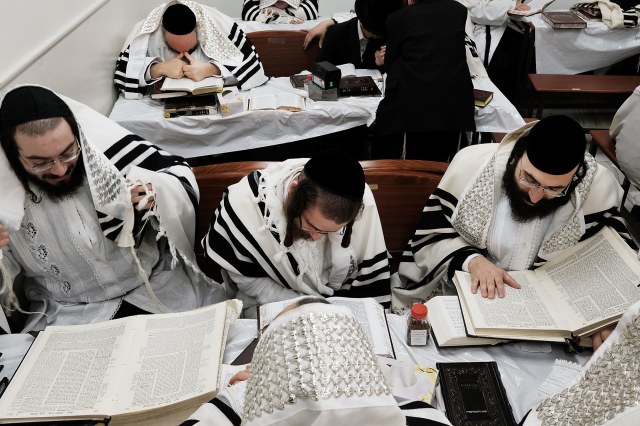Credit: Spencer Platt/Getty Images

According to the story we commonly tell ourselves, the modern world begins with the eighteenth century – the Enlightenment, the American and French revolutions, the Industrial Revolution and so on. It’s a story that assumes increasing secularisation, the dominance of technology and the triumph of market capitalism. “Modernity is a deal” writes the Israeli author Yuval Noah Harari, “The entire contract can be summarised in a single phrase: humans agree to give up meaning in exchange for power.” But the eighteenth century, this crucible of modernity, was also the century of powerful religious revivalism.
In England, John Wesley by-passed the narrow confines of establishment Christianity, preaching directly to the poor, with emotion and passion. And in doing so helped light the fire of the so-called first Great Awakening. From this movement, modern Charismatic Christianity was born.
At the same time, in south eastern Poland, an almost exact contemporary of Wesley, Israel ben Eli’ezer – or the Ba’al Shem Tov or Besht – began a comparable awakening within Judaism that came to be known as Hasidism. Like Wesley, the Besht wasn’t a formal theologian. He emphasised popular devotion and the religion of the heart. Drawing upon older Kabbalistic traditions, the Besht and his followers encouraged Judaism away from what they regarded as a dry and elitist Rabbinic legalism and towards greater enthusiasm, popular story telling and the unselfconscious joy of divine worship.
Hasidism had its opponents, of course. Lithuanians, under the leadership of the serious minded Vilna Gaon, looked down upon the excitable Hasidim. And the growing movement for a Jewish Enlightenment wanted Jews to find their place in the modern world of progress. Nonetheless, throughout the nineteenth century Hasidism became the dominant form of popular Jewish piety in central Europe.
And whilst the whole ultra-orthodox family – Hasidim and Lithuanians and others, known collectively as Haredi – were almost wiped out in the Holocaust, their post-Holocaust revival has been extraordinary. No longer based in central Europe, they have nonetheless taken the dress code and customs of their eighteenth century predecessors and transported them to New York and Israel, and also to places like Stamford Hill in North London.
And the Heredi family are growing fast – both in absolute terms and as a percentage of the Jewish community as a whole. In Israel, the Heredi community are forecast to become 40% of the Israeli population by 2065 – up from 14% in 2015. Likewise, in the UK, the Heredi community
continues numerically to flourish and is set to overtake the ‘mainstream’ Jewish community in the mid to latter part on this century.
For a group that was very nearly wiped out by the Nazis, this revival has been astonishing – and, if the forecasts are correct, is set radically to change the demographics of Jewish life, both here and in Israel.
Haredi men, for instance, believe it their duty to devote their lives to study. They take the injunction in Isaiah 11 that “the earth shall be filled with the knowledge of the Lord” to mean that studying Torah is an end in itself. So, for example, in Israel, Heredi politicians are currently pressing the Netanyahu government for a return to full exemption from military service for the Heredim. They want no restriction on those who want to spend their lives praying and studying Torah.
They also demand an increase in state subsidies so that men do not have to go out to work. Around 50% of Heredi men do not have paid employment. For many secular Israelis, all these exemptions and subsidies stick in the throat, especially as a number of the Heredim think of the whole Zionist enterprise as a secular project, and as having little role in defining their Jewishness. Indeed, some Heredi remain openly hostile to the Israeli state and there have been a number of reports of Heredi men who have been persuaded to join the army being beaten up when they return to their communities.
As the numbers of Heredi grow, so too the tension increases between the Israel of capitalist enterprise and technology start-ups and the community of learners seeking to fulfil the Biblical mandate to fill the earth with the knowledge of the glory of God. Many argue that, at some point, Israel will not be able to afford to subsidise half of its Heredi men to spend their lives studying Torah.
On the other hand, the Heredim may well be ahead of their time. Like a number of futurologists, Yuval Noah Harari, the best-selling author of Homo Deus: A Brief History of Tomorrow, is warning us that technological advance will soon render many of us unemployed and unemployable: “the crucial problem isn’t creating new jobs. The crucial problem is creating new jobs that human beings perform better than algorithms”, he argues.
“The same technology that renders humans useless might also make it feasible to feed and support the unemployable masses. … The real problem will then be to keep the masses occupied and content. People must engage in purposeful activities, or they go crazy. So what will the useless class do all day?”
For some the answer is clear: study Torah.
What I admire about the ultra orthodox community is that they remain stubbornly committed to their own values, that they have not merged with the prevailing culture of secular progress and market capitalism. Who knows: perhaps they are ahead of their time?










Join the discussion
Join like minded readers that support our journalism by becoming a paid subscriber
To join the discussion in the comments, become a paid subscriber.
Join like minded readers that support our journalism, read unlimited articles and enjoy other subscriber-only benefits.
Subscribe